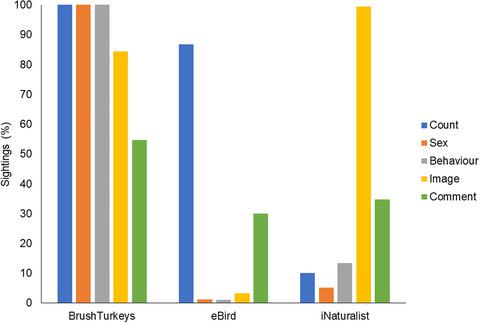当前位置:
X-MOL 学术
›
Austral Ecol.
›
论文详情
Our official English website, www.x-mol.net, welcomes your feedback! (Note: you will need to create a separate account there.)
Ecological insights into a charismatic bird using different citizen science approaches
Austral Ecology ( IF 1.5 ) Pub Date : 2021-05-31 , DOI: 10.1111/aec.13062 Matthew J. Hall 1 , John M. Martin 1, 2 , Alicia L. Burns 1, 2 , Dieter F. Hochuli 1
Austral Ecology ( IF 1.5 ) Pub Date : 2021-05-31 , DOI: 10.1111/aec.13062 Matthew J. Hall 1 , John M. Martin 1, 2 , Alicia L. Burns 1, 2 , Dieter F. Hochuli 1
Affiliation

|
Citizen science projects provide valuable ecological data owing to their capacity to collect a wide variety of data at scales that would be difficult to achieve through traditional methods. A trade-off exists between the complexity of data collected and participation, with projects typically falling into a continuum between documenting the presence of species at a location, through to the collection of detailed ecological data using complex protocols. Researchers must balance an approach that suits their aims with maximising participation. However, the ability of different citizen science approaches to collected detailed ecological data for a target species is poorly understood. We compared the number of participants and amount of data collected from the three projects to explore different citizen science approaches for focal species research. We examine data for the Australian brush-turkey (Alectura lathami) from two open survey citizen science projects and one focal species project: iNaturalist, eBird and BrushTurkeys. Over a period of 18 months, eBird recorded the greatest number of participants (n = 1861) and presence records of brush-turkeys (n = 17810). Across the three projects participation varied significantly with an average of 1.95 (range = 1–65), 9.6 (range = 1–389) and 4.7 (range = 1–331) reports per citizen scientist, respectively. The targeted BrushTurkeys project collected specific ecological data including counts, sex and behaviours in a higher proportion of sightings and recorded the largest number of nest mound reports compared with eBird and iNaturalist. We confirm that engaging an active group of participants produced the largest amount of data (eBird), including reports per participant. Ecologically, the most detailed information on habitat use and behaviours came from the focal citizen science project (BrushTurkeys). We conclude that seeking opportunities to grow and actively engage existing citizen science communities to report more detailed ecological information is likely to produce more detailed and informative data set.
中文翻译:

使用不同的公民科学方法对有魅力的鸟类进行生态洞察
公民科学项目提供了宝贵的生态数据,因为它们能够以传统方法难以实现的规模收集各种数据。在收集的数据的复杂性和参与之间存在权衡,项目通常陷入记录某个地点物种存在到使用复杂协议收集详细生态数据之间的连续体。研究人员必须在适合其目标的方法与最大限度地参与之间取得平衡。然而,人们对不同公民科学方法收集目标物种详细生态数据的能力知之甚少。我们比较了从三个项目中收集的参与者数量和数据量,以探索不同的公民科学方法进行重点物种研究。Alectura lathami)来自两个公开调查公民科学项目和一个重点物种项目:iNaturalist、eBird 和 BrushTurkeys。在 18 个月的时间里,eBird 记录了最多的参与者 ( n = 1861) 和刷火鸡的存在记录 ( n = 17810)。三个项目的参与度差异很大,每位公民科学家的平均报告分别为 1.95(范围 = 1-65)、9.6(范围 = 1-389)和 4.7(范围 = 1-331)。与 eBird 和 iNaturalist 相比,有针对性的 BrushTurkeys 项目在更高比例的目击事件中收集了特定的生态数据,包括数量、性别和行为,并记录了最多数量的巢丘报告。我们确认让活跃的参与者群体产生最大量的数据 (eBird),包括每个参与者的报告。在生态方面,关于栖息地使用和行为的最详细信息来自焦点公民科学项目 (BrushTurkeys)。
更新日期:2021-05-31
中文翻译:

使用不同的公民科学方法对有魅力的鸟类进行生态洞察
公民科学项目提供了宝贵的生态数据,因为它们能够以传统方法难以实现的规模收集各种数据。在收集的数据的复杂性和参与之间存在权衡,项目通常陷入记录某个地点物种存在到使用复杂协议收集详细生态数据之间的连续体。研究人员必须在适合其目标的方法与最大限度地参与之间取得平衡。然而,人们对不同公民科学方法收集目标物种详细生态数据的能力知之甚少。我们比较了从三个项目中收集的参与者数量和数据量,以探索不同的公民科学方法进行重点物种研究。Alectura lathami)来自两个公开调查公民科学项目和一个重点物种项目:iNaturalist、eBird 和 BrushTurkeys。在 18 个月的时间里,eBird 记录了最多的参与者 ( n = 1861) 和刷火鸡的存在记录 ( n = 17810)。三个项目的参与度差异很大,每位公民科学家的平均报告分别为 1.95(范围 = 1-65)、9.6(范围 = 1-389)和 4.7(范围 = 1-331)。与 eBird 和 iNaturalist 相比,有针对性的 BrushTurkeys 项目在更高比例的目击事件中收集了特定的生态数据,包括数量、性别和行为,并记录了最多数量的巢丘报告。我们确认让活跃的参与者群体产生最大量的数据 (eBird),包括每个参与者的报告。在生态方面,关于栖息地使用和行为的最详细信息来自焦点公民科学项目 (BrushTurkeys)。


























 京公网安备 11010802027423号
京公网安备 11010802027423号